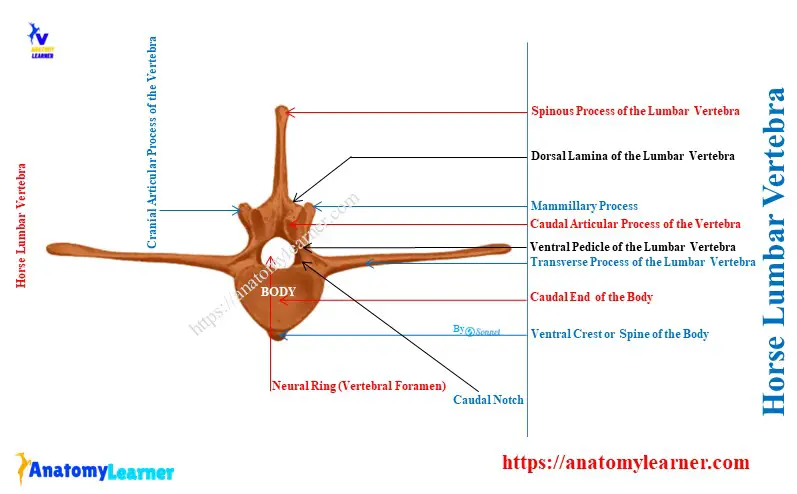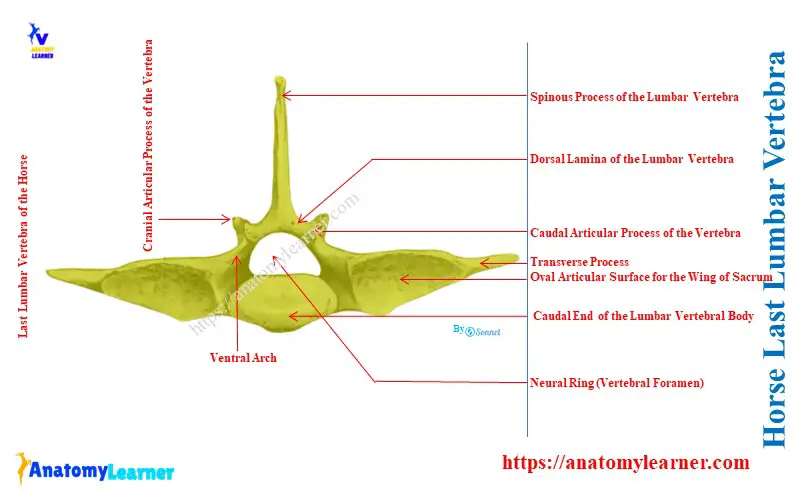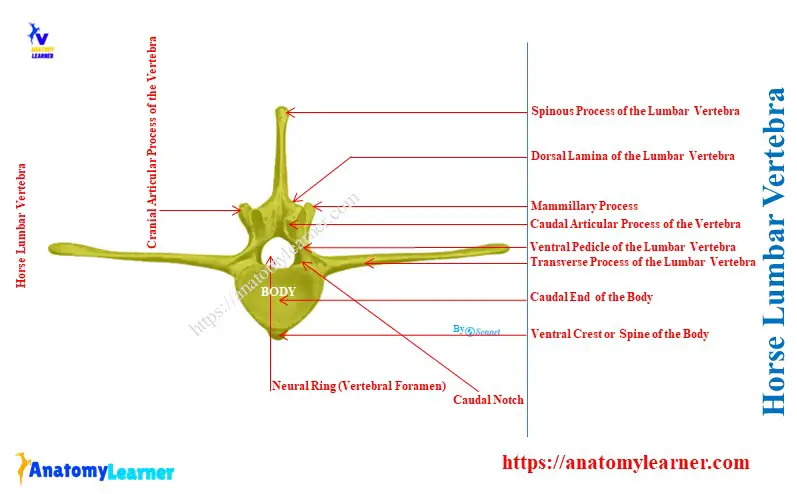The lumbar vertebrae of a horse form the bony roof of the abdomen with their bodies and long transverse processes. Here, I will describe the osteological features of the horse lumbar vertebrae with the labeled diagram.
Quick overview: six (6) lumbar vertebrae are in a horse vertebral column. They are characterized by the size and form of their transverse processes.
I will also show the key differences between the horse and ruminant lumbar vertebrae. Let’s get started to learn the features of the body, arches, and processes of the lumbar vertebrae.
Horse lumbar vertebrae
The horse lumbar vertebrae possess bodies, arches, and three processes like the typical vertebra. First, let’s identify the below-mentioned osteological features from a horse lumbar vertebra –
- Body of the lumbar vertebra with two ends (cranial and caudal), and two surfaces (dorsal and ventral),
- Arches (right and left) of the vertebra with ventral pedicles, and dorsal laminae,
- There are three different processes: cranial and caudal paired articular, paired transverse, and single spinous processes.
The labeled diagram of a horse’s lumbar vertebra identifies all these features. With the diagram, you will learn the detailed features of the horse’s vertebral bones.

Body of the horse lumbar vertebra
The bodies of the equine lumbar vertebrae are quite different from those of the ruminant’s lumbar vertebrae. Here, the bodies of the first three lumbar vertebrae of a horse are semi-elliptical in cross-section. These three lumbar vertebrae present a dorsal, almost flat surface, and a distinct ventral crest.
The bodies become wider and flatter from the fourth lumbar vertebra. Again, the ventral crest of the fourth to sixth lumbar vertebrae subsides.
The bodies of the lumbar vertebrae have two ends: cranial and caudal. The cranial end is convex and smooth and attaches to the caudal end of the corresponding vertebra. Again, the caudal end is concave and attaches to the cranial end of the corresponding vertebra.
So, exceptional osteological features of the bodies of the lumbar vertebrae:
- Bodies are semi-elliptical on cross-section and become flattened caudally,
- The ventral crest of the bodies gradually diminishes,
Arches of the lumbar vertebrae
The arches of the horse lumbar vertebra consist of a pedicle and a lamina. Here, the ventral pedicle of the lumbar vertebrae forms the lateral wall of the neural ring, and the dorsal lamina forms the roof of the neural ring.
The right and left lateral pedicles possess notches at the cranial and caudal aspects. The intervertebral foramina are between the notches of the adjacent lumbar vertebrae.
The arches of the first three lumbar vertebrae of a horse are about equal in size. They are also structurally similar to those of the last thoracic vertebrae of the horses.
The arches of the other vertebrae increase in breath and height. The posterior notches on the arches are deeper than the anterior notches on the horses.
Articular processes of the equine lumbar vertebrae
Both the cranial and caudal articular processes of the horse lumbar vertebrae arise from the junction of the lamina and pedicle.
These articular processes of the lumbar vertebrae forms the diarthrodial joint with similar process of the adjacent vertebrae. They prevent the undesirable movement between the adjacent lumbar vertebrae.
The cranial or anterior articular process of the equine lumbar bone is fused with the mamillary process. Dorsally, it presents a concave surface for articulation with the caudal pair of the preceding vertebrae.
The caudal articular surface of the horse lumbar vertebra distinctly projects from the arch at the base of the spinous process. It possesses ventrally convex articular surfaces, which fit into the concave surface of the cranial pair of the next vertebra.
Transverse process of the lumbar vertebrae
The transverse process of the lumbar vertebrae is on either side and projects outward from the lateral aspect of the neural ring. Let’s see the typical features of the transverse process from the horse lumbar vertebrae –
- They are elongated plates, flattened dorsoventrally,
- These processes project outward and usually curve slightly downward,
- Their length increases to the third or fourth and then diminishes to the last,
- The first one or two typically curve somewhat backward, the last two decidedly forward,
Exceptional osteological features in the transverse process of the horse lumbar vertebra:
The fifth transverse process possesses an oval concave facet on the medial part of the posterior border. It articulates with the sixth transverse process of the horse lumbar vertebra.
Thus, the cranial border of the sixth transverse process possesses a convex articular facet. Again, the caudal border of this transverse process has a larger concave surface. This larger concave surface articulates with the wing of the horse sacrum.
Sometimes, the fifth transverse process has small facets for articulation with the fourth. The medial part of the sixth transverse process is thick.
Meanwhile, the lateral part is thinner, narrower, and curved forward. The medial part of the fifth transverse process is also thickened.

Spinous process of the horse lumbar vertebra
The spinous processes of the horse lumbar vertebrae are single. It projects upward from the junction of the right and left laminae.
These spinous processes in the horse’s lumbar vertebrae resemble those of the last two thoracic vertebrae. They are usually about equal in height with little difference, but the width diminishes in the last three lumbar vertebrae.
How many lumbar vertebrae does a horse have?
Answer: There are 6 (six) lumbar vertebrae in a horse’s vertebral column. These six lumbar vertebrae possess the typical features of the body, arches, and processes.
The body of the first three are semi-elliptical and become wider from the fourth lumbar vertebrae. The height and breadth of these six lumbar vertebrae increase gradually.
The transverse processes of the fifth and sixth lumbar vertebrae have more distinct and unique features. The presence of caudal concave facets on the caudal border of the transverse process easily differentiates the horse’s last lumbar vertebrae from others.
Conclusion
The horse lumbar vertebrae’s body, arches, and processes possess unique osteological features. Their bodies are elliptical, and caudal notches on the arches are deep in the horse’s lumbar vertebra.
The transverse processes are elongated and flattened, and facets are found in the last two. In particular, the caudal facets on the last lumbar transverse process are more distinct and articulate with the wing of the sacrum.

